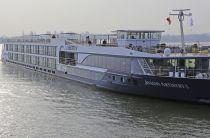Blaye (Cussac-Fort-Medoc, France)
Cruise Port schedule, live map, terminals, news
Region
France Rivers
Local Time
2025-04-13 02:00
 53°F
53°F 11.4°C

 Light breeze
Light breeze2.6 m/s
 66 °F / 20 °C
66 °F / 20 °C 50 °F / 10 °C
Port Blaye cruise ship schedule shows timetable calendars of all arrival and departure dates by month. The port's schedule lists all ships (in links) with cruises going to or leaving from Blaye, Cussac-Fort-Medoc, France. To see the full itineraries (ports of call dates and arrival / departure times) and their lowest rates – just follow the corresponding ship-link.
| Day | Ship | Arrival | Departure |
|---|---|---|---|
| 30 March, 2025 Sunday | 09:00 | 01 Apr, 08:00 | |
| 30 April, 2025 Wednesday | |||
| 30 April, 2025 Wednesday | |||
| 2 April, 2025 Wednesday | |||
| 2 April, 2025 Wednesday | |||
| 3 April, 2025 Thursday | |||
| 3 April, 2025 Thursday | 09:00 | 05 Apr, 08:00 | |
| 6 April, 2025 Sunday | |||
| 7 April, 2025 Monday | 09:00 | 08 Apr, 05:00 | |
| 8 April, 2025 Tuesday | 14:00 | ||
| 9 April, 2025 Wednesday | |||
| 9 April, 2025 Wednesday | |||
| 10 April, 2025 Thursday | |||
| 10 April, 2025 Thursday | |||
| 11 April, 2025 Friday | |||
| 11 April, 2025 Friday | 23:00 | 12 Apr, 12:00 | |
| 13 April, 2025 Sunday | |||
| 16 April, 2025 Wednesday | |||
| 16 April, 2025 Wednesday | |||
| 16 April, 2025 Wednesday | |||
| 17 April, 2025 Thursday | |||
| 17 April, 2025 Thursday | |||
| 18 April, 2025 Friday | |||
| 20 April, 2025 Sunday | |||
| 21 April, 2025 Monday | |||
| 22 April, 2025 Tuesday | 23:00 | 23 Apr, 12:00 | |
| 23 April, 2025 Wednesday | |||
| 23 April, 2025 Wednesday | |||
| 24 April, 2025 Thursday | |||
| 27 April, 2025 Sunday | |||
| 28 April, 2025 Monday | |||
| 28 April, 2025 Monday | |||
| 28 April, 2025 Monday | 23:00 | 29 Apr, 12:00 |
Blaye is a Gironde River cruise port and town in France's Aquitaine region (Bordeaux Prefecture). The town is on the estuary of River Gironde and is the site of an imposing Citadelle built by Marquis de Vauban (1633-1707, a French military engineer). The citadel (the town's fortified area) overhangs the estuary and allows for magnificent panoramic views over the river.
Blaye is also one of the gateways to the Medoc wine region's vineyards, along with Le Verdon-sur-Mer and Margaux-Cantenac.
Medoc (translated as "middle land") is named as the peninsula is between Atlantic Ocean and Gironde Estuary. Its position allows huge streams of water to act as thermal regulators creating the perfect microclimate for the vineyards. The first Medoc vineyard was created in the 16th century, while most vineyards were established by mid-18th century. As early as 1730, topping up of casks (to compensate for headspace / ullage) and racking were introduced to keep the wines longer.
The name of the region comes from the local Celtic tribe Medullicus, or "country of the Medulli". The region owes its success mainly to red wine production. Medoc is home to ~1500 vineyards. The area also features long sandy beaches and pine forests.
The geography of Medoc is not perfect for wine growing, with the proximity to the Atlantic Ocean which results in high rainfall and comparatively mild climate making rot a permanent problem. It is generally thought that the nature of Medoc's wine derives from the soil. Even though the terrain is flat, exceptional drainage is a necessity: the increased amount of gravel in region's soil allows heat to be retained, thus encouraging ripening, as well as extensive root systems.
Inside Blaye Town are the ruins of an ancient Gothic chateau/country house containing the tomb of Charibert II, son of Clotaire II and the king of Aquitaine. Blaye is also defended by Fort Pate (on an island in Gironde) and Cussac-Fort-Medoc (on the river's left bank), both from the 17th century. From here passengers can also visit the Bourg village, built on a rocky outcrop and enclosed by medieval ramparts. The next photo shows the fortifications of Blaye Citadelle.
Blavia (Blaye) was a port of the Santones in ancient times. Tradition states that Frankish hero Roland was buried in Blavia's basilica, which was on the site of today's citadel. It was an important stronghold that played an important part during the wars against the English (who burned it in 1352) and the French Wars of Religion (1593).
- Cruise Industry

Avalon Waterways expands to Bordeaux with new river cruise itinerary
Avalon Waterways has officially launched homeporting operations from Bordeaux (France), introducing a new itinerary along the Garonne and Dordogne...
March 27, 2025 - show more news
